Everyone who’s ever had a small aquarium has probably faced a number of difficulties in his choice of fish.

Even though bettas are notorious for their feistiness, you’ll be surprised to find that there are numerous setup ideas and tank mates that can be used in their 5-gallon tank home.
In my experience, betta fish get along with some types of tetras, rasboras, and a host of other aquatic species regardless of the size of their living space. I’ve summarized all of these species in a list which should help you find the best buddies for your betta fish in its 5-gallon tank.
The 13 Best Betta Tank Mates for a 5-Gallon Tank
Even though betta fish can be kept in a 5-gallon aquarium, they can become territorial if they feel their space is being challenged by the presence of too many unwelcome guests. To avoid unwanted battles within your aquarium, you should understand which species can safely interact with bettas in a 5-gallon tank.
So here are the best tank mates for a 5-gallon betta aquarium:
1. Mystery Snail – Pomacea bridgesii
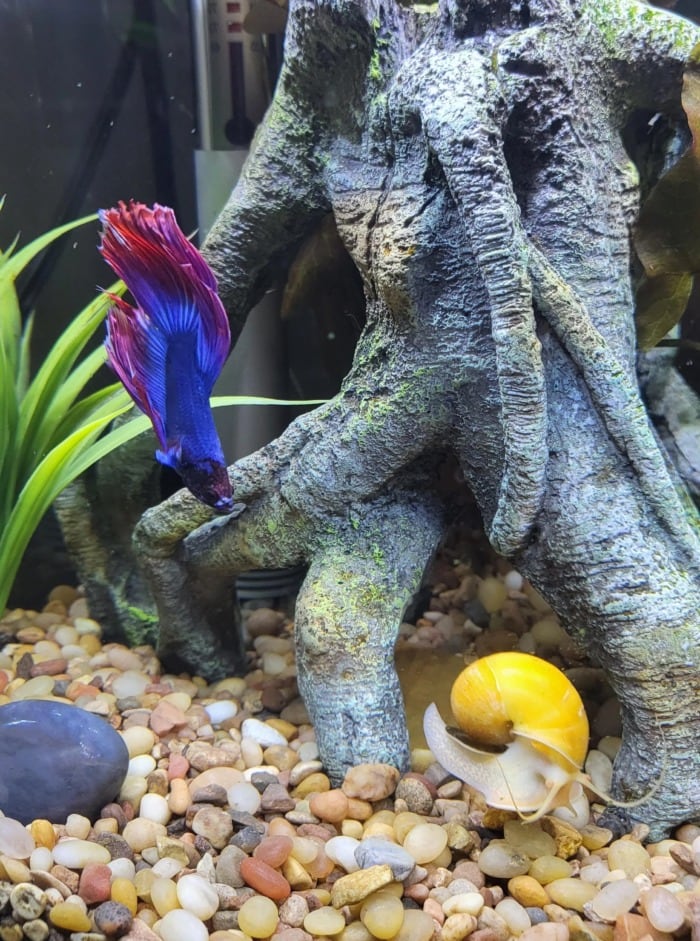
by morbatts
| Maximum size: | 1.5 – 2 inches (3.8 – 5 cm) |
| Water temperature range: | 67 to 81 °F (19.4 to 27.2 °F) |
| Gets along with: | Bamboo shrimp, ghost shrimp, red cherry shrimp, rasboras, tetras, bettas, etc. |
| Suitable for Beginners: | Yes |
The mystery snail known as Pomacea bridgesii is a great betta fish companion for anyone who is trying to bring a little more life and movement to their tank.
These bottom feeders are great at tidying up the aquarium while bringing peaceful vibes to the inhabitants around them.
Mystery snails grow up to 2 inches so you won’t have to worry about them being eaten by your betta fish.
These snails are easy to care for if you’re a beginner, but they do prefer hard water to be at their healthiest.
2. Spotted Nerite Snail – Vittina natalensis
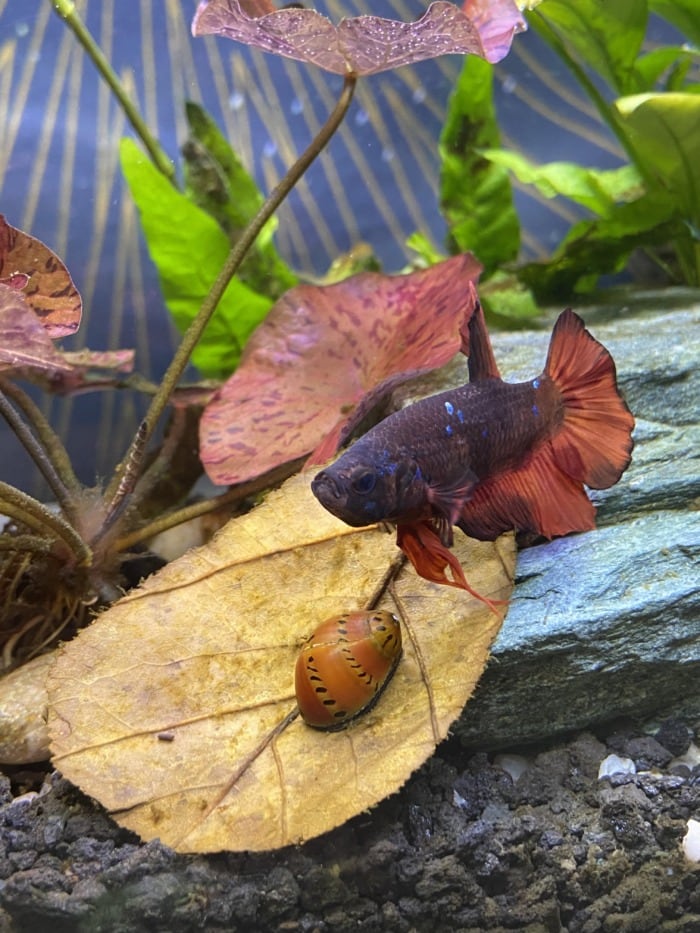
by erika9708
| Maximum size: | 0.5-1 in (1.25-3.8 cm) |
| Water temperature range: | 72 – 78°F (22 – 26°C) |
| Gets along with: | smaller peaceful community fish, shrimp, and other snails, NO cichlids, goldfish, loaches or crayfish |
| Suitable for Beginners: | Yes |
As is the case with most snails on this list, Vittina natalensis is a peaceful and active member of its ecosystem that enjoys having a tidy environment to live in.
The laidback and easygoing nature of the Spotted Nerite Snail makes it a great addition for anyone who is looking for a new tank mate to live with their betta.
From my observation, this snail is one of the best options when it comes to diversifying the population of your aquarium.
They are colorful, clean the tank, and can’t reproduce in freshwater, which helps to create a memorable experience for any beginner aquarium owner who is setting up a new tank.
Author’s note: These snails are quite active, so keep a close eye to ensure they don’t escape.
3. Pygmy Corydoras – Corydoras pygmaeus
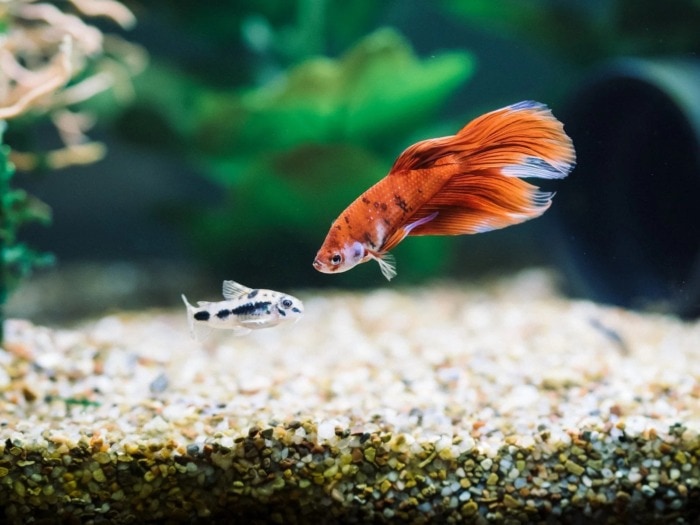
by pawo9
| Maximum size: | 1 inch (2.5 cm) |
| Water temperature range: | 72 – 79 °F (22 – 29 °C) |
| Gets along with: | Neon tetras, dwarf gouramis, cherry barbs, guppies, and some dwarf cichlids. |
| Suitable for Beginners: | Yes |
I know from experience that bettas can get particularly aggressive which is displayed by flaring their gills when challenged by other feisty fish or when feeling cramped by too many other occupants. That’s what makes the Corydoras pygmaeus a great companion to add when considering what fish will get along best within your 5-gallon betta tank.
Pygmy corydoras are friendly and will avoid confrontation whenever possible, which lowers the possibility of deadly altercations within the tank.
Their temperament and versatility make them a great option for beginner aquarists.
Just maintain a clean tank and research their diet well to ensure they have their best chance at survival.
4. Ghost Shrimp – Palaemonetes paludosus

by luxelavishxo
| Maximum size: | 1.5 inches (3.8 cm) |
| Water temperature range: | 65 – 82 °F (18 – 28 °C) |
| Gets along with: | Snails, cory catfish, cherry shrimp, and Amano shrimp |
| Suitable for Beginners: | Yes |
Ghost shrimp, also known as Palaemonetes paludosus, are wonderful tank companions that keep the environment clean while also staying out of the way of other species within the aquarium.
These aquarium shrimp get along well with bettas due to their non-aggressive behavior and their ability to reproduce quickly.
Author’s note: Some overly-aggressive Betta fish may try to eat the adult shrimp in their tank, no matter the species. That’s because Bettas are carnivorous micro predators by nature. However, it has been my experience that the more agile shrimp generally tend to fair well and are able to maintain a population in Betta tanks.
Anyway, Ghost shrimp are a popular choice amongst aquarium enthusiasts, but they are delicate when it comes to the environment they live in.
Too many pollutants or an unstable environment can easily kill these fragile shrimp.
5. Red Cherry Shrimp – Neocaridina davidi
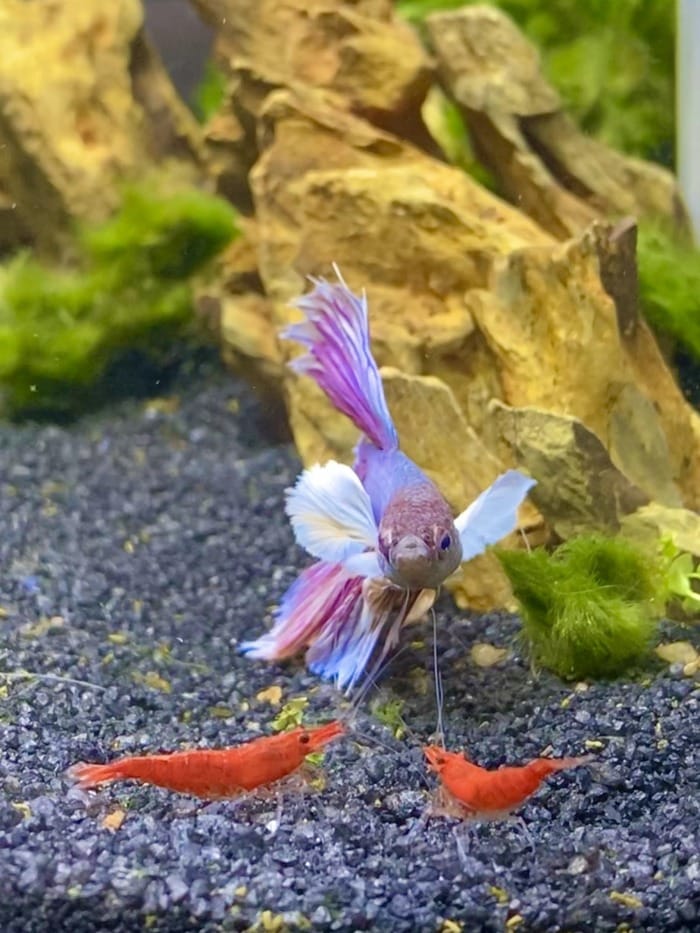
by SnakeJunkie8
| Maximum size: | 1.5 inches (3.8 cm) |
| Water temperature range: | 68 – 84 °F (20 to 28.8 °C) |
| Gets along with: | Amano shrimp, snails, neon tetras, chili rasboras and otocinclus catfish |
| Suitable for Beginners: | Yes |
If you’re looking for shrimp species that are hardy, nonviolent, and good cleaners, you might want to include a couple of cherry shrimp in your tank.
Red cherry shrimp, also known as Neocaridina davidi in the scientific community, are a good fit for betta fish due to their agile nature and lower position in the tank.
They are hardy and easy to care for, so beginners shouldn’t feel intimidated when considering adding a few of these shrimp.
If you decide to include these adorable shrimp in your tank, then you should do so before adding your Betta.
In some rare cases, Bettas might try to eat cherry shrimp, so by introducing the fish later, you give your cherry shrimp more time to find hiding spots.
6. African Dwarf Frog – Hymenochirus

by On_a_dishy
| Maximum size: | 3 inches (7.5 cm) |
| Water temperature range: | 72 – 78 °F (22 – 25 °C) |
| Gets along with: | African dwarf frogs, guppies, sub-tropical danio species, corydoras, and peaceful tetras. |
| Suitable for Beginners: | No |
The Hymenochirus is docile by nature and often seeks refuge amongst hides and plants when it feels threatened.
In fact, the African Dwarf Frog is so adept at hiding that it might lead you into believing it has somehow escaped your tank.
Upon further inspection, however, you’ll realize it’s simply hiding amongst the foliage.
If you have a temperamental betta, it’s best to seek out tank inhabitants that know how to stay out of the way on tougher days.
Consequently, the camouflage abilities of the African Dwarf Frog make it an ideal companion for Betta fish.
In my opinion, I would not classify African Dwarf frogs as beginner-level for a few reasons.
They are susceptible to multiple diseases and can even get you sick if they aren’t handled properly, so do your research before including them in your tank.
Author’s note: Some African Dwarf Frogs may become bloated due to a condition called dropsy. Dropsy hinders the osmoregulation of frogs and leads to a buildup of fluids all over their body.
7. Chili Rasbora – Boraras brigittae
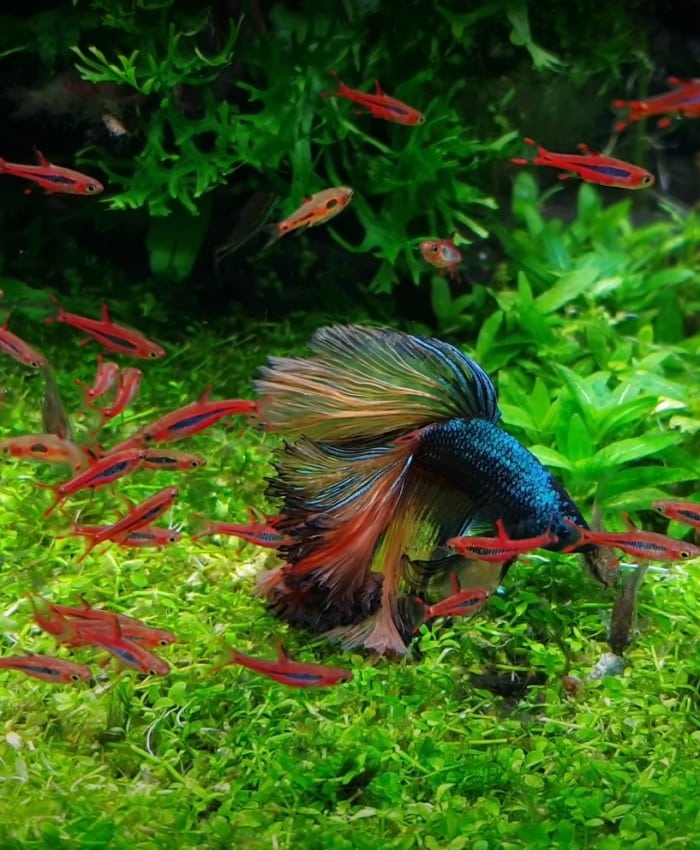
by Martin Vrzák
| Maximum size: | 0.8 inches (2 cm) |
| Water temperature range: | 75 to 82.4 °F (23.9 to 28 °C) |
| Gets along with: | Neon tetras, dwarf gouramis, red cherry shrimp, pygmy corydoras, and others. |
| Suitable for Beginners: | No, these fish are sensitive to changes in water parameters and prefer a more acidic environment |
Chili rasboras, also known as Boraras brigittae are gorgeous red fish with a dark stripe that runs along their body and a peaceful personality that can calm even the angriest of fish. As is the case with most of the fish on this list, the Chili Rasbora tends to stay away from anything they deem to be a threat.
If you have the patience and time to ensure a very clean tank, these are a great choice to add to your list of stocking ideas.
Just keep in mind that the tank needs to be cleaned regularly and maintained to avoid disease and illness spreading amongst the inhabitants.
8. Strawberry Rasbora – Boraras naevus

by mm
| Maximum size: | 0.7 inches (1.8 cm) |
| Water temperature range: | 77 – 82 °F (25 – 28 °C) |
| Gets along with: | Amano shrimp, cherry shrimp, peaceful rasboras, neon tetras, and others. |
| Suitable for Beginners: | No |
Similar to its chili counterpart, the strawberry rasbora has a peaceful personality and prefers to school in groups of 6 or more.
Boraras naevus can be housed with bettas due to their passive nature and quick swimming abilities.
Their small size allows them to hide easily and move quickly to avoid potentially dangerous situations.
Although they are hardy fish with lots of energy, they need very specific water and tank requirements to survive.
Anyone willing to put in the effort to properly support this type of fish will be greatly rewarded with the playfulness they add to the tank.
9. Phoenix Rasbora – Boraras merah

by plyr__
| Maximum size: | 0.8 inches (2 cm) |
| Water temperature range: | 68 – 83 °F (20 – 28.3 °C) |
| Gets along with: | Amano shrimp, cherry shrimp, snails, neon tetras, and others. |
| Suitable for Beginners: | No |
If you’re still not sure what to put in your 5-gallon betta tank, look no further than the Phoenix Rasbora.
These fish are docile for the most part but can become territorial when spawning, so make sure they have enough room to move about.
They can live happily with bettas due to their calm demeanor, and similar water requirements.
Phoenix Rasboras are great additions for anyone who often cleans their tank and maintains pristine water quality, but they might be a little harder to keep for people who are just beginning their aquarium journey.
10. Dwarf Rasbora – Boraras maculatus
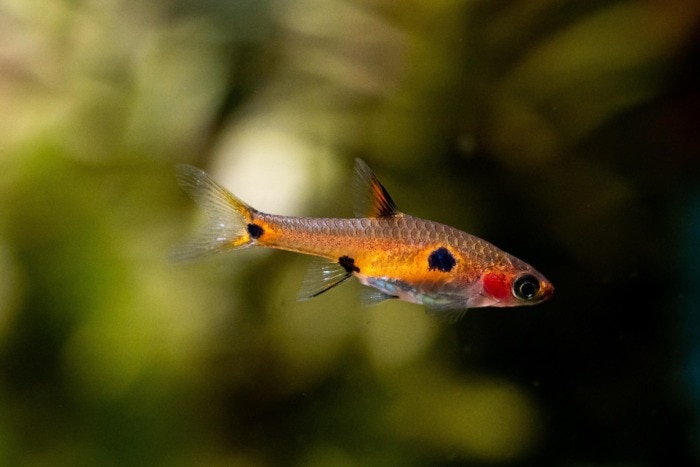
by shoreyourtyler
| Maximum size: | 1 inch (2.5 cm) |
| Water temperature range: | 75 – 79 °F (24 – 26 °C) |
| Gets along with: | Small and peaceful invertebrates |
| Suitable for Beginners: | No |
Like the other varieties of rasbora, this stunning fish is another great option to consider if you want to create an impressive 5-gallon betta tank.
Dwarf Rasboras, less commonly known as Boraras masculatas, are some of the best fish to put with bettas because of their shy and peaceful nature. They spend most of their time hiding between plants at the middle and top of the tank, so they won’t be a hindrance to the bettas by taking up too much space.
I believe that the care of Dwarf Rasboras should be left in the hands of experienced aquarists.
Not only do they need specific water requirements like other rasbora varieties, but they are also more skittish and easily develop sickness as a result.
11. Amano Shrimp – Caridina multidentata
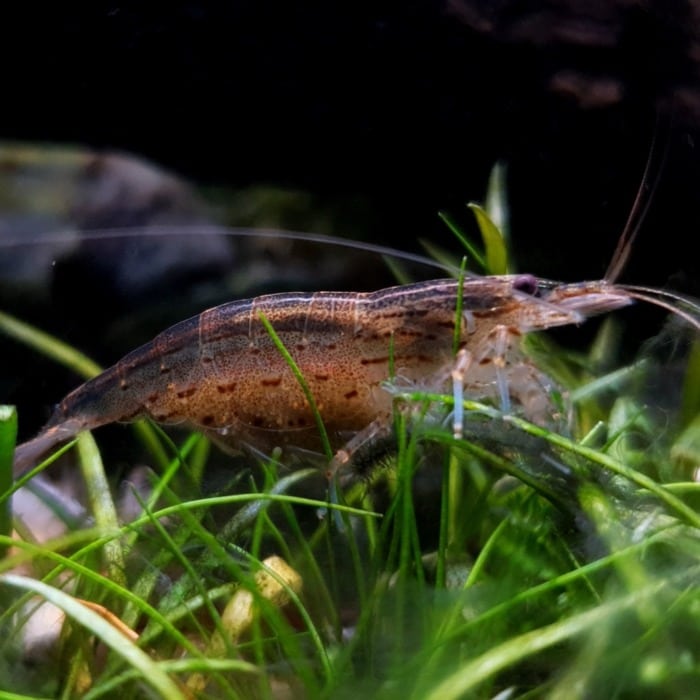
by Mafkees
| Maximum size: | 1.5 – 2 inches (3.8 – 5 cm) |
| Water temperature range: | 65 – 86 °F (18 – 30 °C) |
| Gets along with: | Neon tetras, tiger barbs, guppies, discus, Otocinclus, corydoras, smaller plecos, cherry shrimp, bamboo shrimp, and peaceful snails |
| Suitable for Beginners: | Yes |
Caridina multidentata are peaceful crustaceans that enjoy consuming aquarium algae.
They are docile and rarely cause any concern to other tank mates.
These traits make them a suitable companion for the otherwise feisty betta fish.
Amano shrimp are well known for their extensive cleaning habits.
By including them in your 5-gallon tank you ensure your betta fish is kept in a healthy environment.
These shrimp are low maintenance, so they are another great choice for beginners if you can manage to get your hands on some.
12. Dracula Fish – Danionella Dracula

by legob
| Maximum size: | 0.65 inches (1.67 cm) |
| Water temperature range: | 66 to 78.8 °F (19 – 26 °C) |
| Gets along with: | Celestial pearl danios, neon green rasboras, and other rasboras. |
| Suitable for Beginners: | Yes |
Dracula fish are not only a great choice for a 5-gallon betta aquarium but also a splendid conversation piece.
A quick search of their name online will give you just the right amount of information to dazzle the guests at your dinner party.
The Danionella Dracula are good to pair with betta fish because of their small size and camouflage abilities.
Their solitary lifestyle and inclination to hide only play to their advantage in this case, as it will keep them out of harm’s way.
If you’re a beginner, note that these transparent fish can be somewhat hard to maintain. They require some variety within their diet to stay healthy, but they are much pickier when it comes to the environment of the tank.
13. Male Endlers – Poecilia wingei
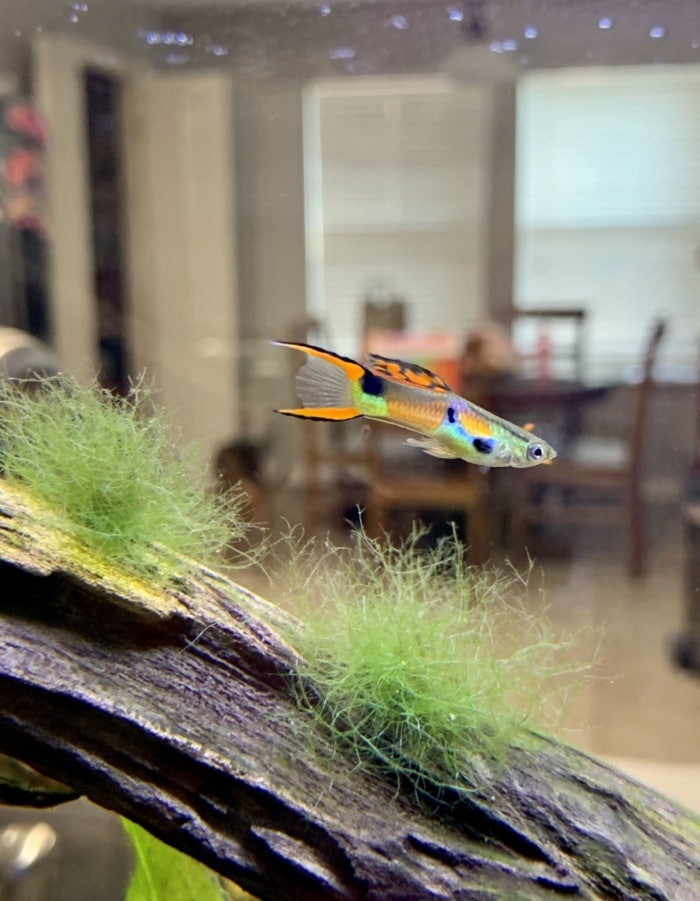
by Fishmanic
| Maximum size: | 1.8 inches (4.5 cm) |
| Water temperature range: | 65 to 80 °F (18.3 to 26.6 °C) |
| Gets along with: | White Cloud Minnows for a cold-water tank, Dwarf Corydoras, small Rainbowfish, smaller non-aggressive tetra species, such as Embers, Pristella, and Neon tetras, other peaceful kinds. |
| Suitable for Beginners: | Yes |
The last fish on the list and easily one of my favorites is the Male Endler, also known as Poecilia wingei. Male Endlers are among my favorite fish species because of their vibrant colors and active personality.
Even though these fish aren’t the most amicable species on this list, they still happen to get along well with bettas due to their passive and carefree nature.
The Male Endler is fairly popular amongst aquarium owners and it is easy to take care of because of its hardiness. So consider adding some to your 5-gallon aquarium to make it stand out.
Author’s note: One thing to remember here is that Endlers won’t work too well if your Betta is overly aggressive. I recommend getting familiar with your particular Betta’s personality before going for Englers as its tank mates.
Some Bettas Can Be Overly-Aggressive Toward Their Companion Fish
A lack of space is one of the main reasons why betta fish display territorial and overly-aggressive behaviors toward their tank mates.
This is why you should avoid overcrowding your aquarium at all costs.
Failure to do so will turn it into a sparring ring regardless of the other fish species in it.

by PunkinGuts
Male bettas in particular show more aggressive behavior in general, so having a male and female together is not the best combination if you want to avoid fighting within the tank.
Female bettas do coexist better, but I don’t recommend adding more than two in a 5-gallon tank since they’ll likely try to establish a hierarchy by fighting each other.
Another possible reason behind the aggressive behavior of some bettas lies in the way they were bred. According to some studies, betta fish that were reared along with others of their kind tend to be less aggressive.
Go for More Than 5 Gallons If Possible
Even though betta fish can live in a 5-gallon tank, you’ll need a larger one if you want to keep your betta with more than just a few companion fish.
A 5-gallon aquarium will allow you to house your betta with no more than six nano fish in it, which isn’t all that many (read rasboras or Dracula danios).
What’s more, if you go this route you’ll also miss out on a number of other fish combinations that would otherwise be possible.
If you get the chance, you should aim for a 10-gallon tank at the least.
This will give you more creative freedom in the selection of your community tank’s inhabitants. You can check out some of the best fish tanks for a betta fish here.
My Final Words
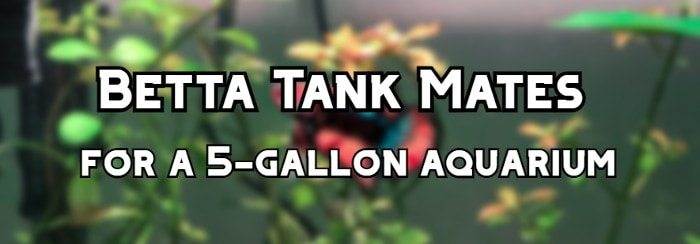
I’ve always loved bettas ever since I was a child.
I didn’t understand how much care was necessary to provide a good home for them when I was younger, but my experience has taught me better.
For beginners, a 5-gallon tank with a betta and a few fish is a great place to start, but when you ultimately fall in love with growing your aquarium, you’re going to want to upgrade your tank to allow a bigger and more diverse ecosystem to flourish.



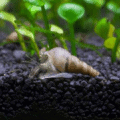

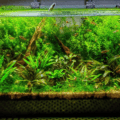

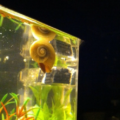



3 thoughts on “13 Popular Betta Tank Mates for a 5 Gallon Aquarium”